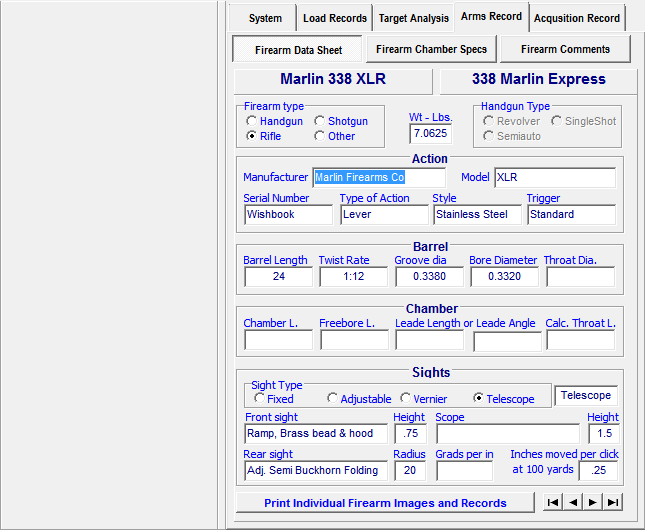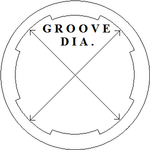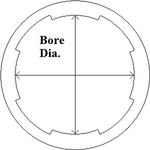Contents
- Index
- Previous
- Next
Firearm Record
The unique Firearm Name and Caliber Designation may be edited from the Grid and Drop Down boxes at the right of the form.
Enter the correct vital statistics into the fields provided below.
Select the Firearm Type as either a Handgun, Rifle, Shotgun or Other.

If the firearm is a Handgun then select the Handgun Type as either a Revolver, Semi-auto or Single shot.. This data is used to show the correct Chamber Specification display.

The Weight of the firearm is used to calculate recoil energy when chronograph and muzzle velocities are recorded for individual targets.
Click on the Page Tabs and Fields in the image below to open context sensitive help topics

The Action panel is used to identify and record your firearm identity statistics
The Barrel panel may be used to record the general barrel configuration and rifling statistics.

The Groove diameter is measured from the bottom of one groove to the bottom of the opposite groove.


The Bore Diameter is measured from the face of one rifling land to the face of the opposite land.
The Throat Diameter Field may be used to record the basic free-bore or starting diameter at the beginning of the rifling in a barrel chamber. Or with a revolver cylinder, record the diameter of the throats at the front of the chamber.
The next panels are used to record basic chamber dimension values.
~
The Cylinder panel will be shown when a firearm with chambers in a cylinder is selected.

After the Cylinder Length, and Chamber Neck Diameter dimensions are recorded, entering the Lead Angle will calculate the cylinder Leade Length or conversely, entering the Leade Length will calculate the cylinder Leade Angle.
Entering the Throat Length will calculate the Chamber Length or conversely, entering the Chamber Length will calculate the Throat Length.
~
The Chamber panel will replace the Cylinder panel when a firearm having the chamber in the barrel is selected.

After the Bore Diameter, Groove Diameter, Chamber Length and Total Free-bore Length dimensions are recorded entering the Lead Angle will calculate the barrel rifling Leade Length or conversely, entering the Leade Length will calculate the barrel rifling Leade Angle. The total distance from the end of the chamber to the end of the rifling leade at bore diameter will be calculated and recorded as the Throat Length.
The Load Record Active Bullet List has an optional provision which calculates a bullet seating depth that will position the bullet ogive or front shoulder to just touch either the forcing cone or the rifling lands. Chamber dimensions that are more precise and detailed than are provided on this page are required for these calculations. These dimensions may be entered from the Firearm Chamber Specs page. However these entries are not necessary for the normal operation of the software.
~
Calculations and comparisons used in the Precision Ballistics and Records Software will require that the Radio Button Boxes, barrel Groove Diameter, Sight Height (either front sight or telescope) above bore center, Sight Radius, rear sight Graduations per inch and Impact Adjustment at 100 yards be correctly entered.
Sight height is measured from the center of the bore to the center of the telescope or to the top of the front sight.
A measuring method that works well with scopes is ~ using calipers, measure the distance from the top of the telescope to the bottom of the barrel. Then measure the diameter of the barrel and the diameter of the scope and subtract 1/2 of each diameter from the first measurement.
The sight radius is pertains to either fixed, adjustable or vernier sights and is measured from the rear face of the front sight to the rear face of the rear sight.
Graduations per inch on adjustable sights may be calculated by determining the threads per inch on the screw adjustment and then, multiply the threads-per-inch value by the number of clicks, stops or marks on the circumference of the adjusting screw to get the clicks or graduations per inch.
Graduations per inch as related to vernier sights is indicated by the number of graduations per inch marked on the side of the vertical sight staff. Most are 20 per inch, some are 40 per inch and others use a different variation The vernier setup will usually allow sub-dividing each of the increments by 5. Therefore 20 graduations per inch will return100 points per inch, resulting in accurate adjustments of 1/100ths of an inch. In the case of a 36-inch sight radius this translates into one inch of impact movement per point of adjustment at 100 yards.
In the case of the adjustable and vernier sights, the impact movement at 100 yards will be automatically calculated after the Graduations per inch are entered into the field. If entries are being entered for a telescope sight, the telescope manufacturer's advertised adjustment increments may be used or the impact movement per click may be physically measured with firing tests.
The contents of the Comments Panel will be limited only by computer disk capacity and may contain as much information as needed.
Copyright (c)2002- 20011. TMT Enterprises. All rights reserved. Modified Sept 2009








